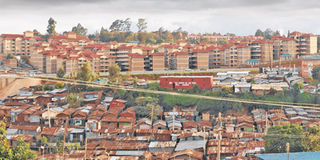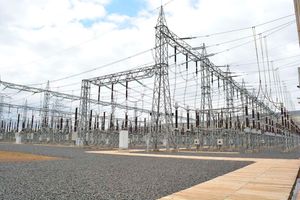Premium
Kibera upgrading project full of contradictions

Some of those moved from the informal settlements in Kibera to better houses rent them out and build new shanties, making a mockery of the government’s efforts to improve their living conditions. PHOTO | LUKORITO JONES |
What you need to know:
- Ironically, Ms Mugure says the living conditions in her current house are not much different from the life she and her neighbours led in the Soweto East slums. In fact, the second-hand clothes’ dealer says she dearly misses the way of life in the slum.
- “What we are striving for is to move the slum residents from living below the poverty line to a Nairobi upper middle-class life,” says Mr. Sikuku “The project was funded almost entirely by the Kenya government at a cost of 3.26 billion,” he says.
- “We urge private investors to join us in offering decent affordable housing to Kenya’s slum population. It might seem like a pipe dream today, but a day is coming when slums will be history in Kenya,” Mr Sikuku says.
The road to Ms Vivian Mugure’s home is long and treacherous. We hop over huge pools of raw sewage, pass by the dilapidated, rusting corrugated iron shanties, and dash through narrow, muddy footpaths.
Some of the places smell awful. When I step on a squishy paper bag, I silently pray that it doesn’t contain human faeces. I am taken aback when I see food vendors selling githeri and fish right next to the murky rivulets that run through the slums.
There are pools of raw sewage all over, and no self-contained houses for at least two kilometres around. “We suspect this sewage comes from the estates in Lang’ata and the prisons,” Ms Mugure says. She points to a river known to the locals as “Sewage”, whose waters are unfit for human consumption, but on whose banks you occasionally see children playing.
“Be careful not to touch the walls of these houses,” she warns when she notices that we’re trying to grab onto the iron-sheet shanties’ walls. “The electric wiring in these houses is shoddy and if you’re not careful, you can get electrocuted.”
These squalid conditions in the overcrowded Kibera slum are what Mugure knew as home six years ago.
“I came to Nairobi when I was 15 to try and eke a living but life consigned me to Kibera,” she says. Mugure lived in Kibera’s Soweto East Zone A before the government relocated the 1,200 households in the area to Lang’ata in 2009 to pave the way for the area’s re-development. After 40 minutes of careful navigation through the slum, we finally finally reach her new home in Lang’ata.
“The Lang’ata site has 613 housing units comprising 17 blocks of three-room, self-contained houses,” says Mr Sikuku. In some of the houses, families were allocated one room each, with a shared kitchen and bathroom.
DEARLY MISSES LIFE IN SLUMS
Ironically, Ms Mugure says the living conditions in her current house are not much different from the life she and her neighbours led in the Soweto East slums. In fact, the second-hand clothes’ dealer says she dearly misses the way of life in the slum.
“Many of problems that we hoped to escape from in the slum have followed us,” she laments.
“We experience acute water shortages here. For instance, blocks A, B, C, P and H have not had running water for more than a month now. Most residents have to queue for a long time for water,” she says.
Ms Angela Atieno, a hairdresser and fellow resident, concurs.
“Even in the blocks that receive water regularly, it is rationed so severely that there is little difference between us and those still out there (in the slums),” Ms Atieno says.
Garbage disposal is also a problem. Numerous rubbish heaps can be seen both inside and outside the gated compound. But the acrid smell that hangs in the air is not from the garbage, but from the sewage that flows through the settlement. “We fear that this might expose us to diseases such as cholera,” a worried Ms Atieno says.
“My family of four shares a house with two families with four members each. We have many problems, especially when it comes to sharing the kitchen,” offers Ms Atieno. “We hope the government will take this issue of house-sharing into consideration in future relocation projects.”
For Peter Masinde, who operates a motorcycle taxi, security is the main problem. “Although the area is fenced, our gates are not manned, so you have all sorts of people loitering in the compound, some with sinister motives. This month alone, fuel has been siphoned from my motorcycle three times,” he complains.
According to the Director of Kenya Slum Upgrading Programme (Kensup), Mr Charles Sikuku, the densely populated Kibera Soweto East Zone was divided into four zones for systematic re-development.
And Mr Sikuku, believes that the residents are ungrateful, and that their problems are self-inflicted. “The government collects a minimal fee for each room as monthly rent, so it is absurd for the tenants to shift the blame to us,” he says.
Mr Sikuku says that the issues raised by the tenants are management problems, for which they should take full responsibility. “According to the Sectional Properties Act, the residents themselves are required to form management committees to run the place. If any problems arise, it is their responsibility to resolve them through the committees,” he asserts.
But perhaps the biggest challenge facing slum upgrading projects is that they run the risk of ending up benefiting the wrong people. At the Lang’ata site where rent is Sh700 for a room and Sh2,100 per unit, many of the intended beneficiaries, the slum dwellers, have sub-let their houses.
“Individuals who were lucky to get an entire house usually end up using only one room and subletting the other two for Sh2,500 each,” Ms Atieno confirms. Worse still, some individuals let out the entire house and move back to the slum.
“One can earn as much as Sh7,500 a month for a house. This amount is very attractive to some tenants, who then put up shanties along the railway line. Others have even built mabati houses right outside the compound!” Ms Atieno reveals.
Meanwhile, Ms Mugure says that many of her neighbours are complete strangers, people she did not know in Soweto East. She blames the management for cutting deals to allow non-bona fide slum residents to benefit from cheap housing. “If you look around our compound, you will see many cars, some of them luxury models, parked outside. It makes one wonder whether their owners really need government help,” she says.
If nothing is done to arrest the sub-letting, then the government risks achieving slum relocation instead of slum upgrading.
“After the Slum Upgrading Project was launched in 2003,” explains Mr Sikuku, “It was noted that despite efforts to eradicate slums in certain areas, the informal settlements usually cropped up again in a different locality. So in 2005, we adopted policies to help us not only eradicate slums, but also prevent their formation as well. For instance, in our future projects, we plan to make the beneficiaries sign contracts that will make it hard for them to sell or sub-let their property.”
While the residents of Soweto East Zone A grapple with life at the new site, their former houses have since been demolished been replaced with “The Promised Land”.
MOVE THE SLUM RESIDENTS
The project is enclosed by a wall and comprises one-, two- and three-roomed units, each complete with a bathroom, kitchen and balcony. Apart from being connected to the main water supply, it also has a borehole. The project also boasts a two-storied youth centre, a social hall, office space, toilets and gigantic waste disposal bins.
“What we are striving for is to move the slum residents from living below the poverty line to a Nairobi upper middle-class life,” says Mr. Sikuku “The project was funded almost entirely by the Kenya government at a cost of 3.26 billion,” he says.
He further revealed that his department was working on low-interest mortgage plans that would ensure the occupants do not pay rent for a lifetime but own the houses after some time.
“Kensup has also helped set up 36 housing co-operatives that facilitate savings among slum dwellers and hence mobilise funds for an incremental upgrading approach. The Kibera Zone A Co-operative, for instance, has raised more than Sh100 million,” he said.
But while a section of Kibera remains optimistic, one Mr Evans Tangy, who lives beside the railway line, only sees a bleak future. Mr Tangy, who lives in a six square-foot shack with his family, has received a notice to leave the place from Kenya Railways.
“While the government’s efforts to provide decent housing for all might be commendable, the process is too slow to count on,” he laments. “It might take several generations for it to upgrade the whole of Kibera.”
According to the 2012/2013 Kenya Housing Survey, the population in slums and informal settlements is estimated at 9 million. The flagship Kibera relocation project has taken close to seven years from to complete.
If the upgrading programmes continue at the same pace, then the vision of eradicating slums in the country and resettling their 9 million dwellers risks becoming a pipe dream.
The Kensup director cites numerous litigation battles as the reason for the flagship project’s delay.
The remaining Soweto East zones (B, C and D) will take less than two years each to upgrade,” Mr Sikuku promises.
However, he is quick to point out that his department’s mandate is not restricted to providing decent housing for slum residents.“Kensup has been involved in the development of critical social and physical infrastructure, not just in Kibera, but all over the country. The towns that have benefitted from our initiatives include Embu, Eldoret, Nyahururu, Homa Bay.”
Indeed, Kensup spearheaded several projects upcountry, including the construction of the Kamukunji Market in Nyeri and Ziwa la Ng’ombe Primary School in Malindi.
“We urge private investors to join us in offering decent affordable housing to Kenya’s slum population. It might seem like a pipe dream today, but a day is coming when slums will be history in Kenya,” Mr Sikuku says.




